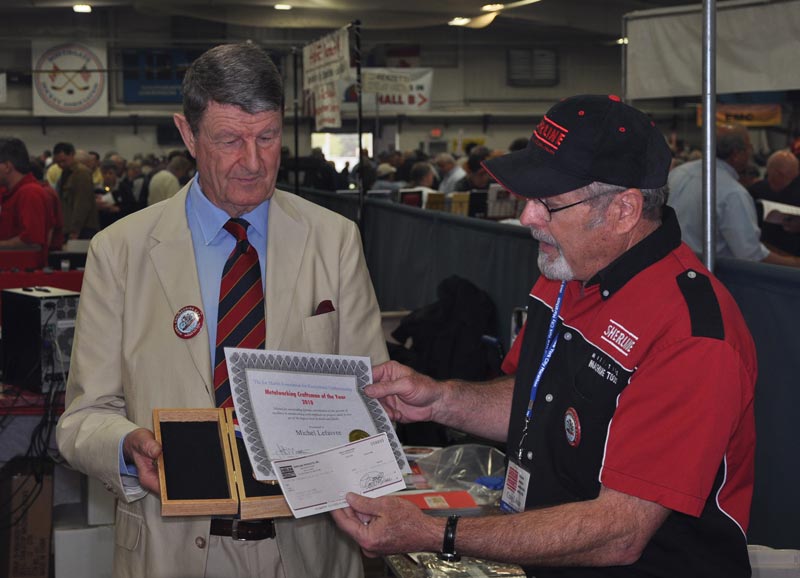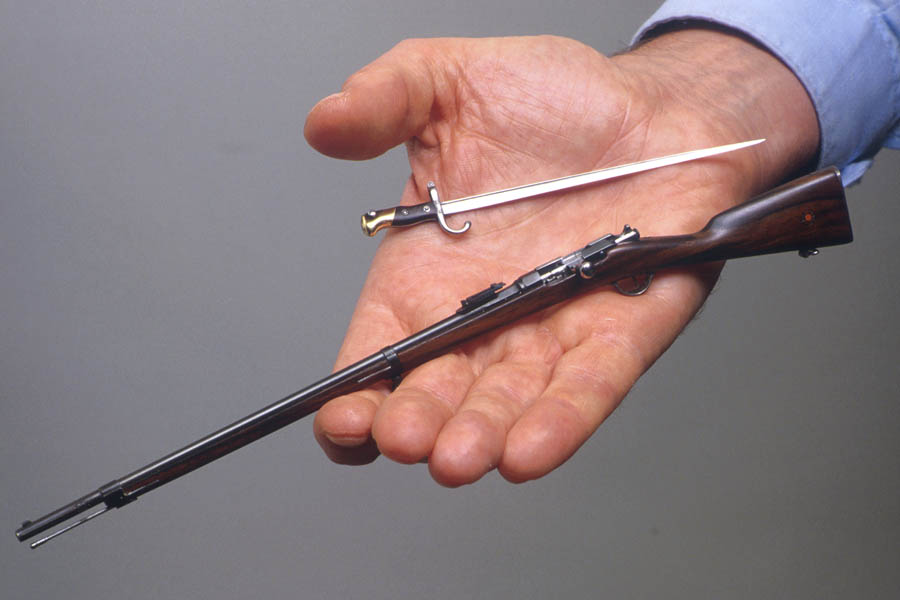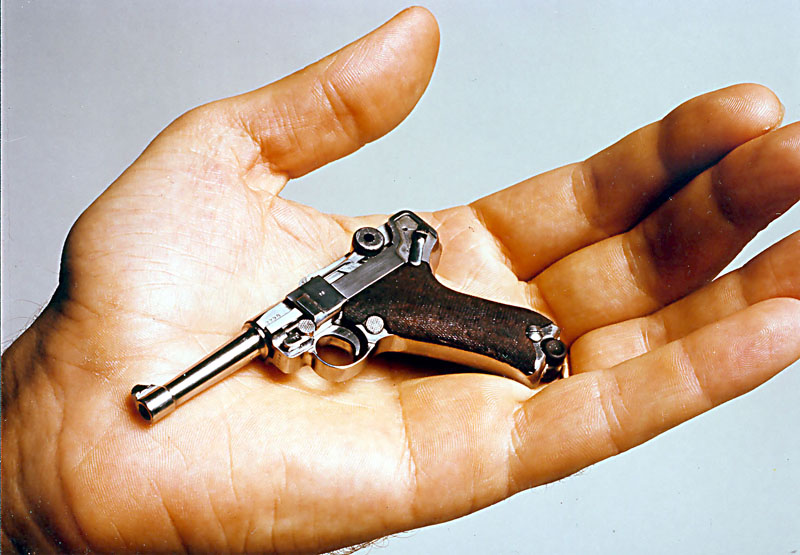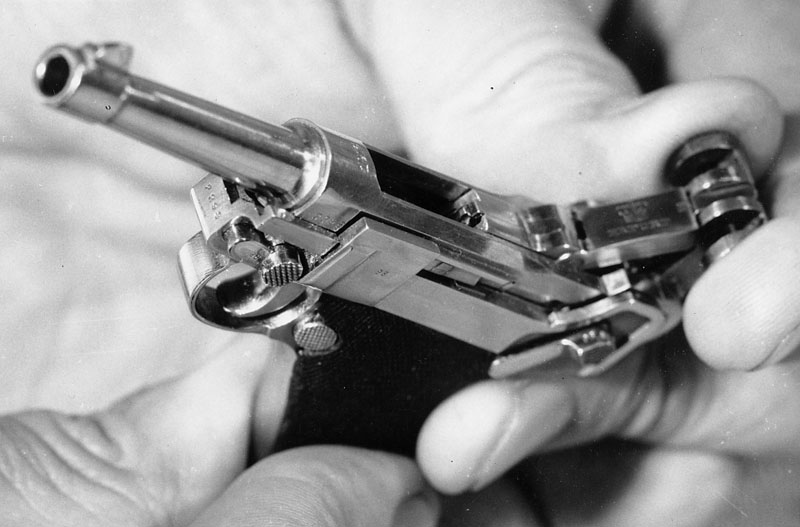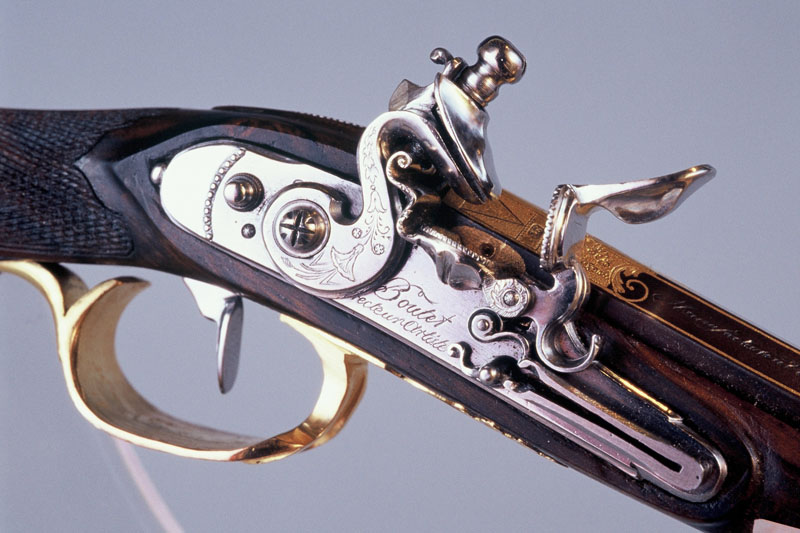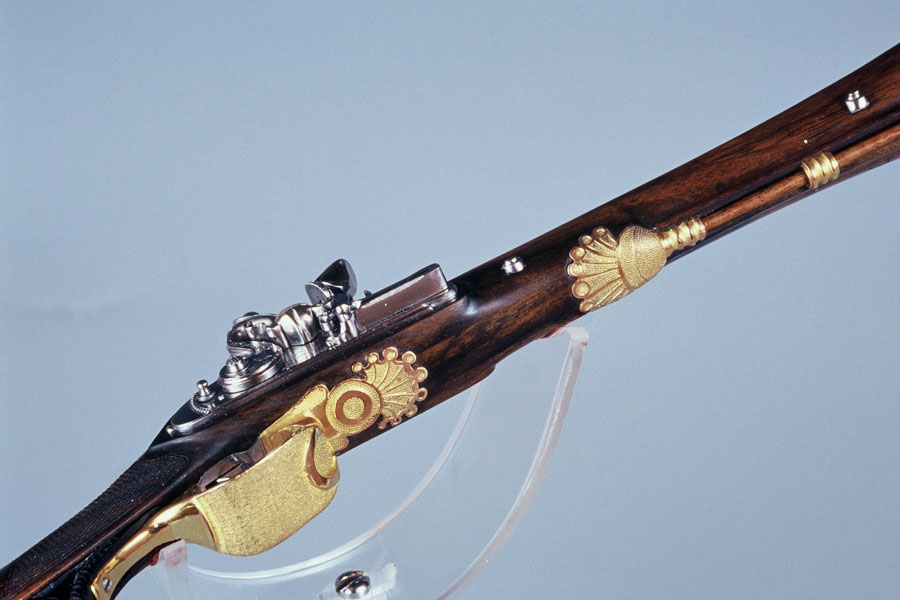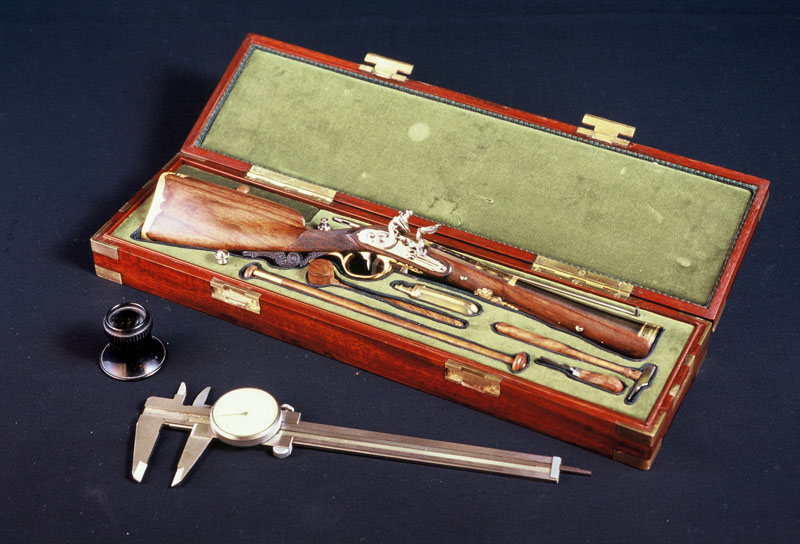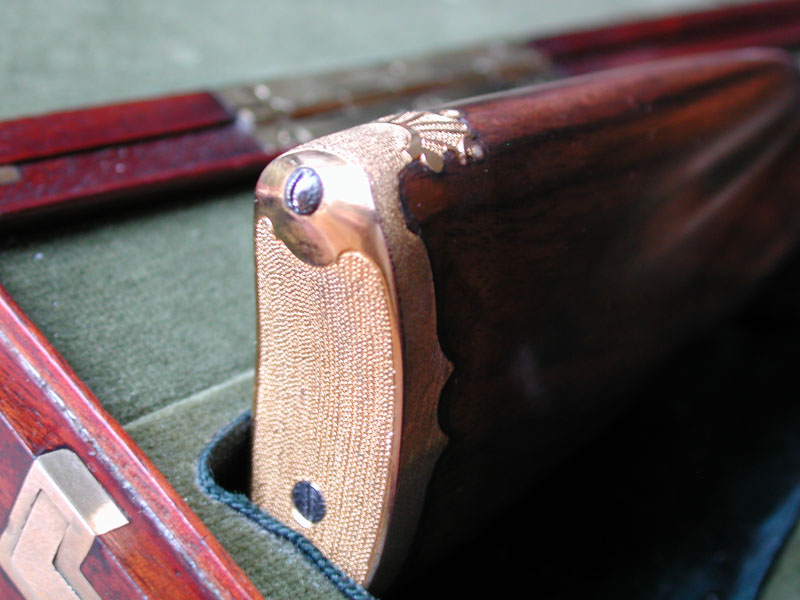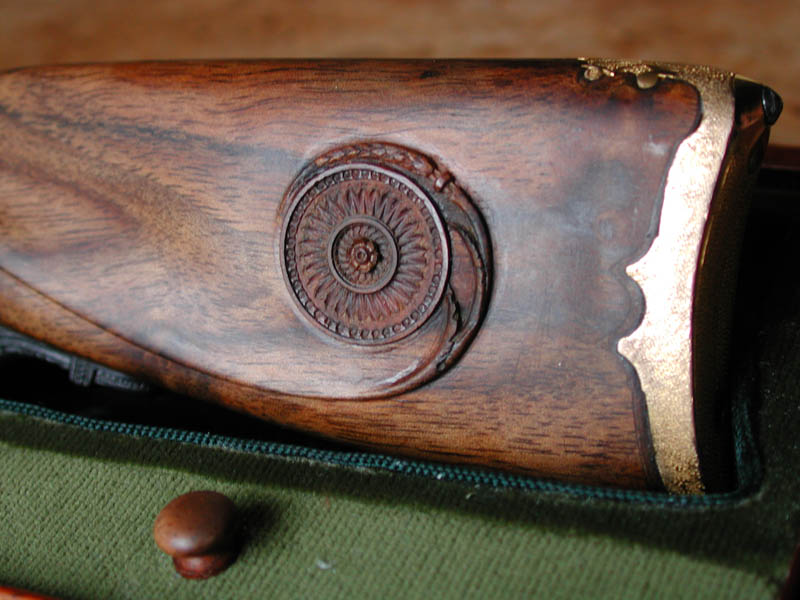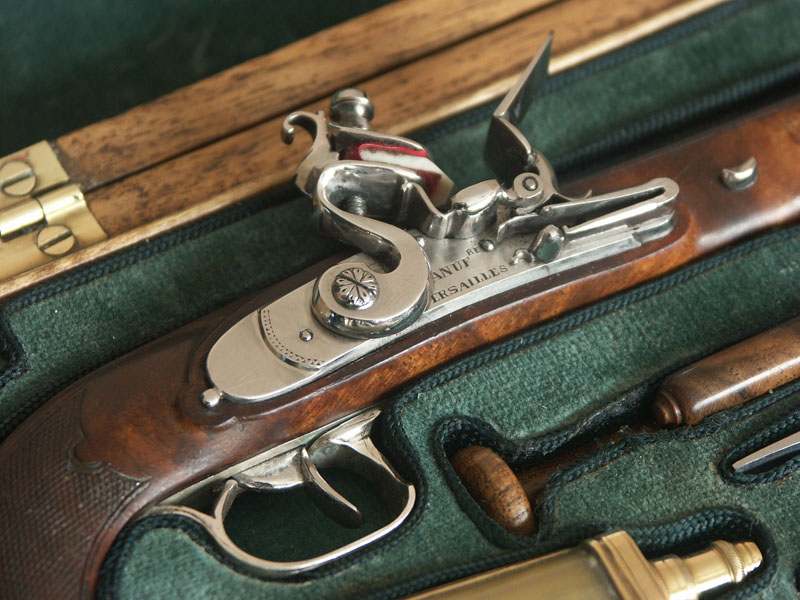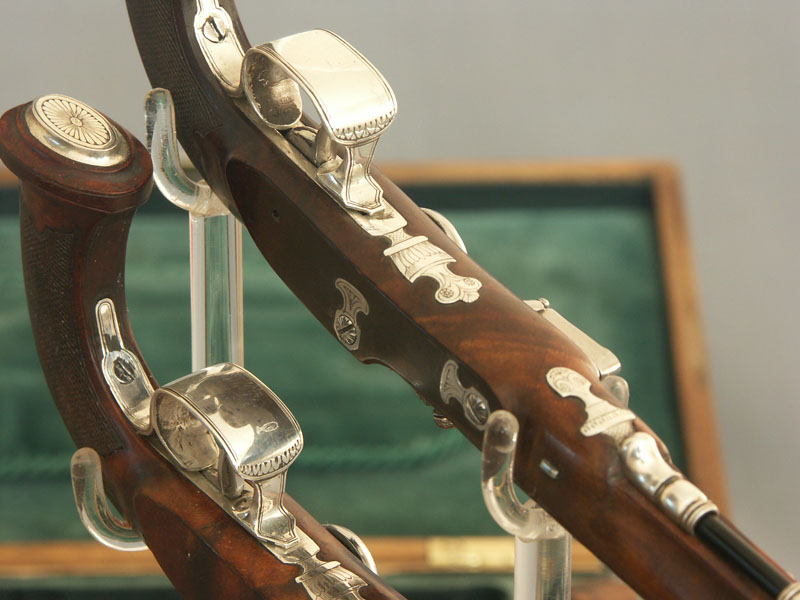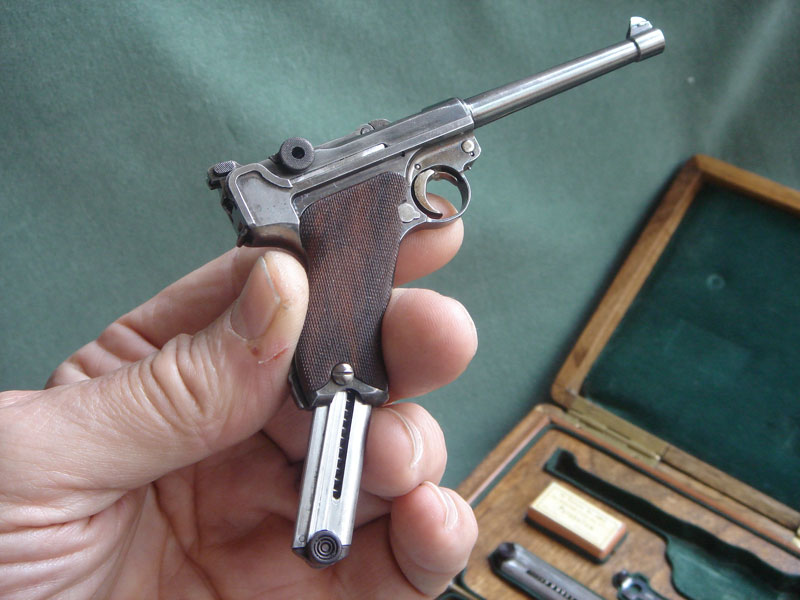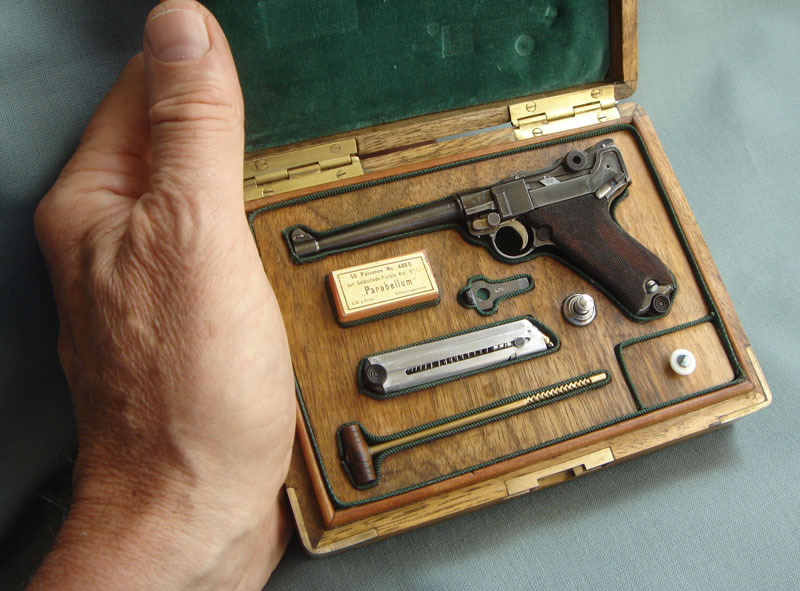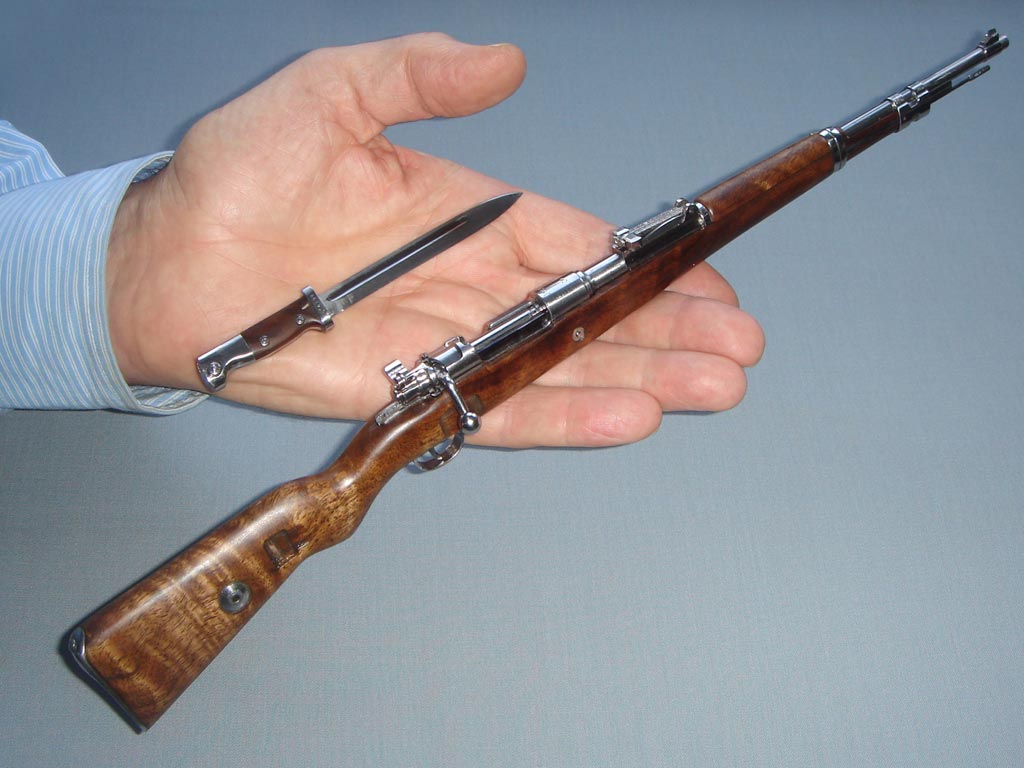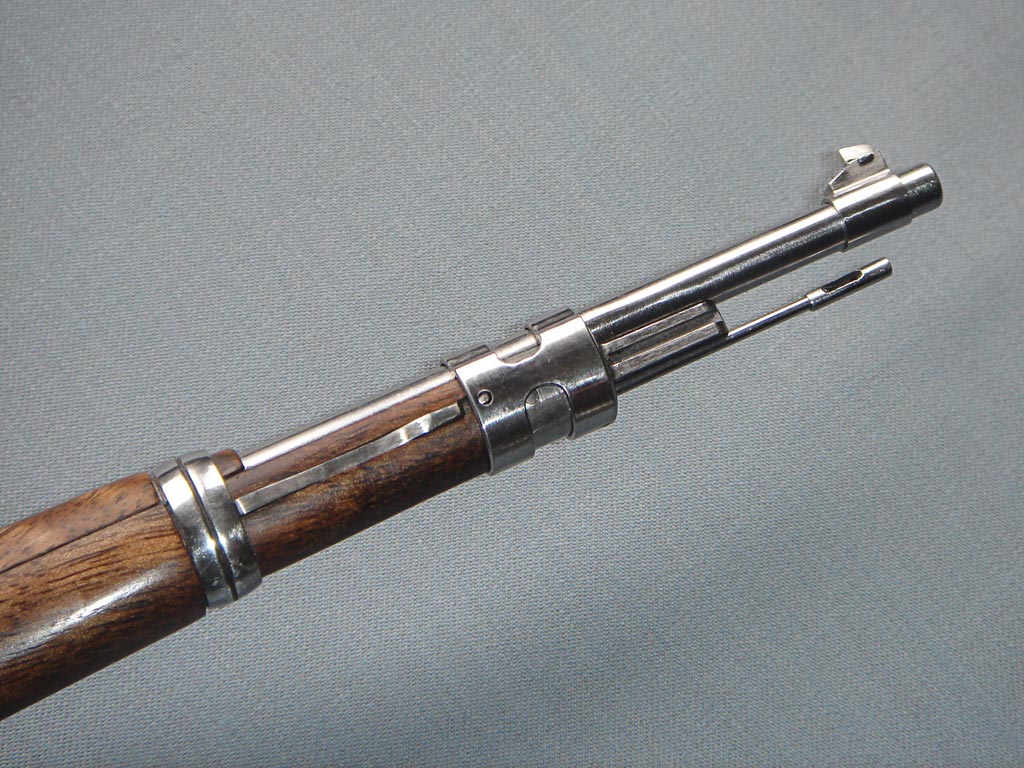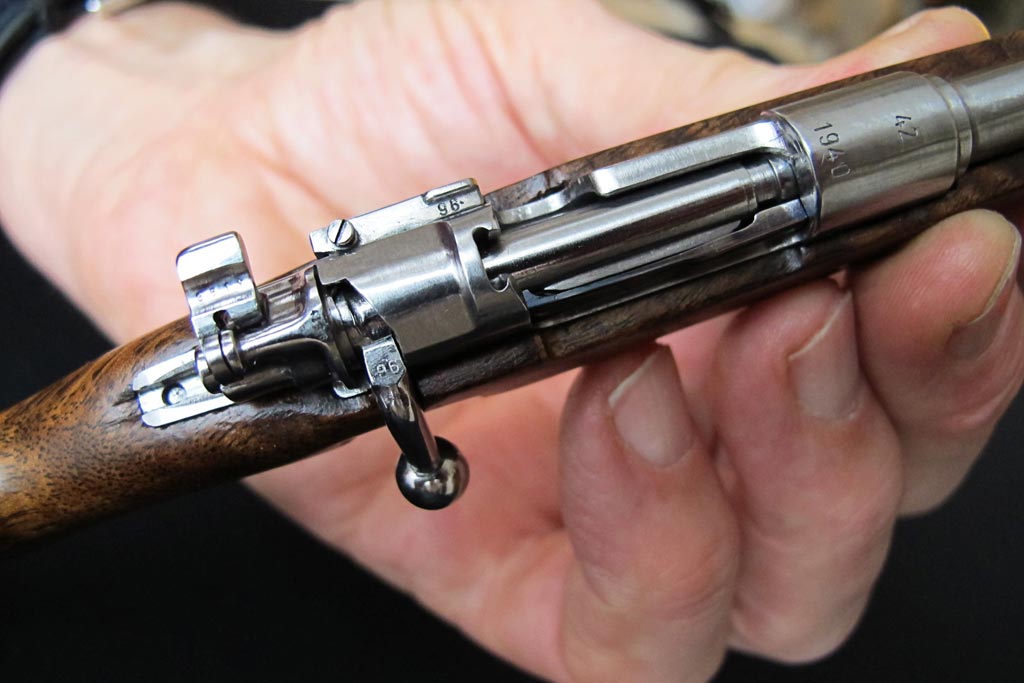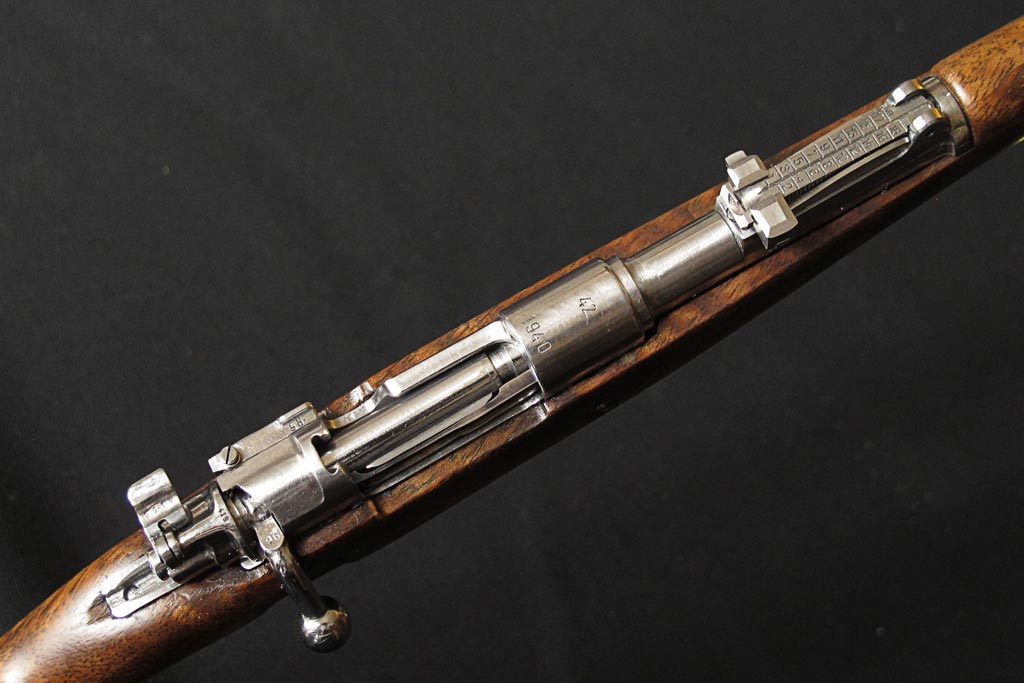Award-Winning Miniature Historic Firearms
Joe Martin Foundation Craftsman of the Year Award Winner for 2010
Introduction
Michel Lefaivre is in a slightly different class from many well-respected miniature arms makers in that he considers himself an “amateur.” This is not meant to reflect the quality of his work; it simply means that he does not make these pieces for a living. Having retired from a career in industry, Michel makes objects of beauty and distinction that meet his owns exacting standards—without regard to profitability or deadlines.
In fact, in the few instances that he has consented to sell a piece, Michel has regretted the sale more than he appreciated the income. Over the course of his miniature making career, Michel has produced several award-winning pieces which are detailed below.
As a result of his dedication, Michel was selected as the 2010 recipient of the Joe Martin Foundation Craftsman of the Year Award. He was presented with the award, an engraved medallion, and a check for $2,000.00 at the North American Model Engineering Society (NAMES) Expo in Detroit, MI on April 24, 2010. We thank Michel for making the long trip from France for the ceremony.
On behalf of the Board of Directors for the Joe Martin Foundation, Craig Libuse (right) presented Michel Lefaivre with his Craftsman of the Year Award. The presentation was held on April 24, 2010 at the NAMES Expo in Southgate, MI. In the second photo, Michel is seen with his engraved gold medallion, symbolizing excellence in craftsmanship. He also received a book on the Joe Martin Foundation featuring all previous winners, which includes a new page on Mr. Lefaivre.
Autobiography
By Michel Lefaivre
I have always been fascinated with model making of any kind. Very early in my childhood, I was able to distinguish the top quality models from the average ones. My own apprenticeship began when I was about 12 years old. I liked to cut a piece of wood and carve it until it resembled something precise, like a car, an aircraft, a boat…a gun stock. I then made more and more difficult models. Simultaneously, I was also fascinated by arms, already knowing that when properly used, they were the key elements of wars—and wars were a key element of history.
As I grew up, I wanted to become a mechanical engineer. This was accomplished by the age of 22. Two years of military duty in 1962-63 in an armoured regiment confirmed my positive interest in weapons, especially handguns. I then held different occupations, such as shipbuilding maintenance engineer, weapon design engineer, and working with gas equipment as an application, sales and export manager in an American company. This gave me a wide experience in industry until I happily retired in 2000.
Catching “Miniature Fever”
The miniature fever was upon me when, in the sixties, I visited the Science Museum in London, and saw all the working steam and Diesel engine scale models. I was so impressed by all these masterpieces that I wanted to do something similar myself, except applied to handguns. I knew I was capable of it, already being a good mechanical fitter. I learned hand-fitting at school, and was the best in that topic (as well as mechanical drawing) from all the years spent in engineering school in Paris.
So, to test my ability to make miniature arms, I started making a simple flintlock mechanism in 1/3 scale, and then the complete pistol. As I was proud of the result, I made a second model of the same pistol to have a pair. Since that time, I have always desired to do better and better, and to improve my skills on each project.
The terms, “outstanding, top quality, museum quality, and masterpiece” were my objectives. I always wanted to increase the level of difficulty, and finding solutions to the resulting problems excited me. It was never without effort—sometimes a lot—but when the work is done, it is so rewarding when you consider the result. I like competition between other craftsmen, but with one small difference: the purpose of my hobby is not to make money. Otherwise, I would have starved!
Although I know how many hours I spent on each piece I made, I have very seldom sold one. I remember when I sold one of my beautiful pieces several years ago. The piece was sold, and a few weeks later the money was spent. I don’t even remember where the money has gone now, but I still miss the piece.
This famous gun is one of the most difficult firearms to make as a working miniature. Michel’s 2/5 scale miniature Luger represents about 600 hours of precision work. The magazine and ammunition were made just like the full-size original, but to scale.
A miniature Boutet pistol, from the famous Manufacture de Versailles, was for me the best that could be done in miniature. After hesitation and reflection, I decided to undertake an encased pair of these pistols in miniature. Fortunately, a friend of mine owned a pair of such treasures that I could use as a model for establishing all the manufacturing drawings.
After more than 1,000 recorded hours of work, I finally finished this pair of Boutet pistols, the case, and all the loading and cleaning accessories. I can say now that one of the most difficult jobs was to make the checkering of the stock to scale, and the special tooling to do it. All the engravings and gold inlays were made by a friend of mine, who is certainly the best engraver in France.
Since that time, I’ve continued to make miniatures of weapons from the never equalled Manufacture from Versailles.
In conclusion, I have always considered top quality as the criteria for making miniatures, without regard for the time spent on them. This explains why I have produced only a small quantity of pieces to my great satisfaction. The following pictures, such as those of the miniature blunderbuss of Prince Eugène (which won the first silver medal at the NRA miniature contest in 2005), will give an idea of what we call a masterpiece in miniature.
Miniature Hunting Blunderbuss of Prince Eugène
The next gun presented is a miniature reproduction, in 1/3 scale, of the hunting blunderbuss that belonged to Prince Eugène de Beauharnais (1781-1824)—Viceroy of Italy, adopted son of Emperor Napoleon 1st, and son of Empress Josephine de Beauharnais. It was awarded a silver medal in the “Best Arms” division by the Miniature Arms Society in 2005.
This miniature is completely functional, one of a kind, and a faithful reproduction in the smallest detail of the full-size weapon. The original was produced under the Empire by the top quality weapons workshop of the famous Manufacture de Versailles, managed by Nicolas Noël Boutet, whose signature is synonymous with the greatest names in the history of the art.
The miniature hunting blunderbuss was made thanks to the great kindness of the Musée du Louvre, and the Museum of Hunting and Nature, located in the beautiful Hôtel de Guénégaud in Paris—where the original weapon is exhibited. It represents two years of effort, with a total of nearly 1,800 hours of work of the greatest precision.
The original blunderbuss, considered by experts as one of the most beautiful guns of this period, is a piece of jewelery itself. A weapon of great elegance, but at the same time highly decorated in the neo-classical style.
Miniature lock plate details show the hammer in swan’s neck style, typical of a Boutet design. It also has an elongated frizzen spring of complex shape, equipped with a roller to reduce friction. “Boutet Directeur artiste,” is engraved on the side plate. The safety device is visible behind the hammer.
The blunderbuss is finely engraved and gold inlaid, but nonetheless of practical design. For this reason, the firearm features in a prominent way on the publicity poster of the Museum of Hunting and Nature.
The quality of the deluxe arms produced by the Manufacture of Versailles, under the direction of N.N. Boutet, has never been equalled to this day. For the manufacture of his deluxe arms, Boutet always looked for difficulty, and gathered together in his workshop the best specialists in each discipline. This included engravers, chiselers, sculptors, gilders, bluers, lock plate makers, barrel makers, stockers, etc. Nothing was left to chance.
The finish of the lock plates was without equal, with the hammer in swan’s neck style, the mirror finish obtained with agate, and the contour on the bevelled edge which was very difficult to make. Look at the contrast of the parts: chiseled, smooth, pearled, or matted. The typical frizzen spring is of elongated and complex shape, and equipped with a roller to reduce friction.
The execution of this hunting blunderbuss in miniature started out as an engineering work. It was necessary to gather a complete technical file, starting with precise photographs showing the numerous details of the weapon. This included the measurement with a caliper or micrometer of all the dimensions, allowing the drawing of each part at the reduced scale. Many visits to the museum were necessary. It was an emotional experience each time I picked up (with white cotton gloves) this magnificent gun of Prince Eugène.
Then came the manufacturing phases. The first order of business was to choose the best materials; that is, those giving the best appearance once polished. Walnut or ebony of best quality for the stock, and fine carbon steel with nickel chrome added for the mechanical parts of the lock and for the barrel. Forgeable spring steel was used for the springs, and old style bronze for the furniture. Then, 24 karat gold wire of different section for the inlay, ivory for the ramrod tip, silk velvet for the lining of the case, etc…
Michel’s 1/3 scale miniature hunting blunderbuss, from the Manufacture de Versailles, which belonged to Prince Eugène de Beauharnais. Prince Eugène was the son of Empress Josephine de Beauharnais, and the adopted son of Emperor Napoléon Bonaparte. He was also a Division General, Viceroy of Italy, and the Duke of Leuchtenberg. Michel made this miniature from 2002-2003. The full-size model is the property of the Louvre Museum, and is exhibited at the Hunting and Nature Museum at Hotel Guénégaud, Paris.
Each part starts from a raw piece of material, reduced in size with a milling machine or a precision lathe. The biggest part of the work is made with a file in the fitting vice. At a quality of manufacture and finish equal to the full size, it is more difficult to make a functioning piece reduced to 1/3 scale.
The more minute the detail, the more time it takes, and the more risk of making a mistake. Few pieces were successful the first time around. All those not strictly in conformity were scrapped without pity.
To perfect the work, and to give it its final touches, the best specialists in the country were called upon for the engraving, inlaying, gilding, checkering, and the wood carving.
Mandatory tooling includes a toolmaker’s lathe, a clockmaker’s lathe, a precision milling machine, and hundreds of needle files of all shapes and grades. Burrs and polishing tools of all shapes, pertaining to clockmakers, jewelers, dentists, chiselers and sculptors were used.
Very good eyesight and an infinite reserve of patience, tenacity, and elbow grease are also required.
There is great satisfaction once the masterpiece is completed, and strictly in accordance with the original. I hope to have paid homage to the master N.N. Boutet, and also to prove to myself that one could still produce work today similar to the deluxe workshop of the celebrated Manufacture de Versailles.
—Michel Lefaivre
Enhancements done by other well-known French artists:
-
Engraving and gold inlay were done by master engraver Yves Sampo of Paris.
-
Wood carving (ebony and walnut) was done by M.O.F. Patrick Blanchard of Paris.
-
Checkering was done by A. Pirrera of St. Etienne.
The blunderbuss butt-plate was one of the most difficult parts to make, and to adjust on the stock, because of its complex shape. The contrast between pearled and smooth surfaces makes the finish even more impressive.
Miniature Dueling Pistol Set—An Imperial Gift
Under the French Empire, a luxurious encased pair of dueling pistols was the most beautiful present that could be offered by the Emperor. They were typically presented as a reward or trophy for feat of arms, as a sign of gratitude, or to honor a statesman, a minister or another important person. To perpetuate this tradition belonging to a prestigious past, and also to meet the challenge of the artist-gunsmiths of the past century, such an encased pair of pistols has been recreated. However, this set has a peculiarity which makes it even more fascinating—it’s a miniature!
Each pistol bears the artist’s stamp, and is a real, entirely handmade piece of jewelry. Their manufacture was executed in the same way as in the past, from the most noble basic materials, such as gold, silver, steel, walnut, ivory, and velvet.
This miniature functions perfectly, and reproduces the tiniest details to scale (2.5 :1). This includes the lock mechanisms, stocks with “powder grain” checkering, all sterling silver furnishings, accessories, and very fine engravings. The octagonal barrels have magnificent 24K gold inlaid scrolls, stylized flowerheads, and geometrical designs on a nice blue ground.
Altogether, this masterpiece reproduces the quality and finish of the famous Manufacture de Versailles, managed by N.N. Boutet, who produced these arms. The outstanding beauty of Boutet’s work has never been equalled in the world—until now.
A view of the flintlock plate shows the typical Boutet design. Engraved on the lock plate is the name, “Manufacture de Versailles.”
A More Modern Weapon—Making a Miniature Navy Luger
In late 2008, Michel published an article in the Miniature Arms Society Bulletin on how he went about making a miniature Navy Luger pistol. We have reproduced the photos that were published in that article in color here.
This photo shows the miniature magazine being pulled out of Michel’s 2/5 scale Luger. Note the typical three concentric rings on the knob of the plain-wood bottom.
A 1/3 Scale Mauser 98K Carbine to Leave You Breathless
By Michel Lefaivre
The following copy was submitted by Michel to describe his work on the Mauser. Photos with captions provided by Michel further document the process below, and in his photo gallery which is linked at the bottom of this page.
As a miniature arms maker for nearly half a century (!!!), I promised myself to someday undertake a 1/3 scale miniature of the famous German Mauser 98K rifle in its tiniest details. It would need to work like the full-size Mauser, on strict accordance to the original Arsenal Manufacturing drawings. This was, for me, what I would call “a postwar teenager’s dream,” having always admired the impressive look and shape of this mythical rifle. I very much like its unique action system with its typical safety device. Moving the big bolt back and forth by its curved head knob creates a nice, greasy, clapping sound, providing a kind of pleasure that is difficult to describe.
Many good books that are very well documented have been published, and cover all the alternate versions and details of this popular rifle. The rifle’s long history is very interesting, but this is beyond the scope of this article. So, I leave you to refer to these books available in all specialized libraries. Just be aware that the most popular model was the 98K, adopted in 1934 by all the German forces, and produced from that period until 1945 by different factories and countries in a quantity of more than 15 million!
Before the Kalashnikov, this 98K was the most widely used rifle in conflicts around the world. Thanks to its precision, reliability, and quantity produced, this rifle remains today a well sought after item by collectors. It is still widely encountered in shooting clubs, or converted to a sporting rifle for hunting. Many spare parts are available through specialized shops or in antique arms fairs.
Now, why did I choose 1/3 scale for this miniature Mauser? I have noticed for many years that most of the complicated miniature guns were made at 1/2 scale. As previously stated, I personally consider a 1/2 scale gun a “scale model” rather than a “miniature.” This is especially true for a rifle, as a 1/2 scale rifle, generally longer than 20″ to 25″, appears to be too long and too big to be called a miniature.
Moreover, a reduction of 2/5, or 1/3, or even smaller makes the miniature much more difficult to build. Besides, there is a scale limit below which it becomes almost impossible to reproduce the tiny details such as engraving, knurling, grip checkering, etc…
I believe that the captions provided on all the accompanying pictures are self explanatory, but I can add several comments or advice:
Should any of you have the intention to undertake such work, you need to have in hand an original full-size model, and establish a precise manufacturing drawing for each part. It will require drawings with all views and useful cross sections at 1/3 scale dimensions and tolerances. This holds true for any kind of miniature, whatever its scale.
It is necessary to be a good and experienced precision machinist, as parts like the receiver, the bolt, and several other main parts are very complicated to machine at 1/3 scale. These parts need many internal and external milling operations requiring specific small handmade cutting tools.
Another well-known problem that may occur during drilling or tapping a small diameter hole on carbon steel is the breaking of the drill or the tap inside the hole—especially when its diameter is close to 1 mm. In most cases, the chances to recover the broken drill or tap from inside its hole are very limited. The best solution is to destroy the inserted bit by electro-erosion, assuming you have access to such equipment. This happened to me a couple of times for the bolt and the trigger/magazine.
As you can observe in the pictures, I didn’t blue (so far) any part of the rifle, preferring to leave it white polished. This creates a beautiful mechanical aspect with sharp edges, as were formerly done by the arsenal’s apprentices to present their miniature masterpieces.
A look at the front end of the miniature barrel. This view shows the tongue-and-groove front sight, adjusted on its open post. It also shows the bayonet lug, cleaning rod, and front and rear band, secured by a band spring.
Though somewhat hesitant to undertake this 1/3 scale mechanical challenge, I finally completed the miniature after almost 2000 hours of labour during 2009 and 2010. This has required lots of high precision milling, lathing, boring, reaming, rifling, polishing, buffing, etc… A great deal of patience and, more rarely, tears! And, of course, a huge quantity of elbow grease.
Finally, and mainly, I have to say that without the tremendous help and advice from my friend Daniel Evennou, a retired precision mechanical engineer, and Yves Sampo, a master engraver, this K98 miniature rifle would not be as it is: A real and unique masterpiece!
I would be happy to share comments and/or answer questions for any of the “few good men” who want to start making such a 1/3 scale K98 Mauser rifle.
—Michel Lefaivre,
MAS member – May, 2011
Articles on Michel Lefaivre
- Article from Société section of Le Journal, March 9, 1984 on Michel Lefaivre and the boxed dueling pistol set: French version with photos. English translation.
- Article from Revue du Musée de l’Armée by Colonel F. Bonnefoy – November, 2005, French version only.
- Article from Miniature Arms Newsletter, October, 2006 shows craftsmanship awards for Michel Lefaivre, Xu Yan, and David Kucer.
- Article from Miniature Arms Newsletter, January, 2009 features the Navy Luger.
Awards for Michel Lefaivre
- 1985—Carcassonne, France: 1st prize at the miniature arms contest—Historical Antique Arms Show. Michel was awarded at this show the title of “Best Non-Professional Gunsmith,” after presenting a miniature pair of Boutet pistols from the Manufacture of Versailles.
- 2001—Awarded silver medal by the Miniature Arms Society, and the “World‘s Best Miniature” for his encased dueling pistol set (Boutet – Manufacture of Versailles).
- 2005—Houston, Texas: Awarded first silver medal by National Rifle Association for his miniature blunderbuss of Prince Eugène. (Boutet – Manufacture of Versailles).
- 2010—Received the Joe Martin Foundation Craftsman of the Year Award.
View more photos of Michel’s incredible miniature historical firearms, and the construction processes behind them.


